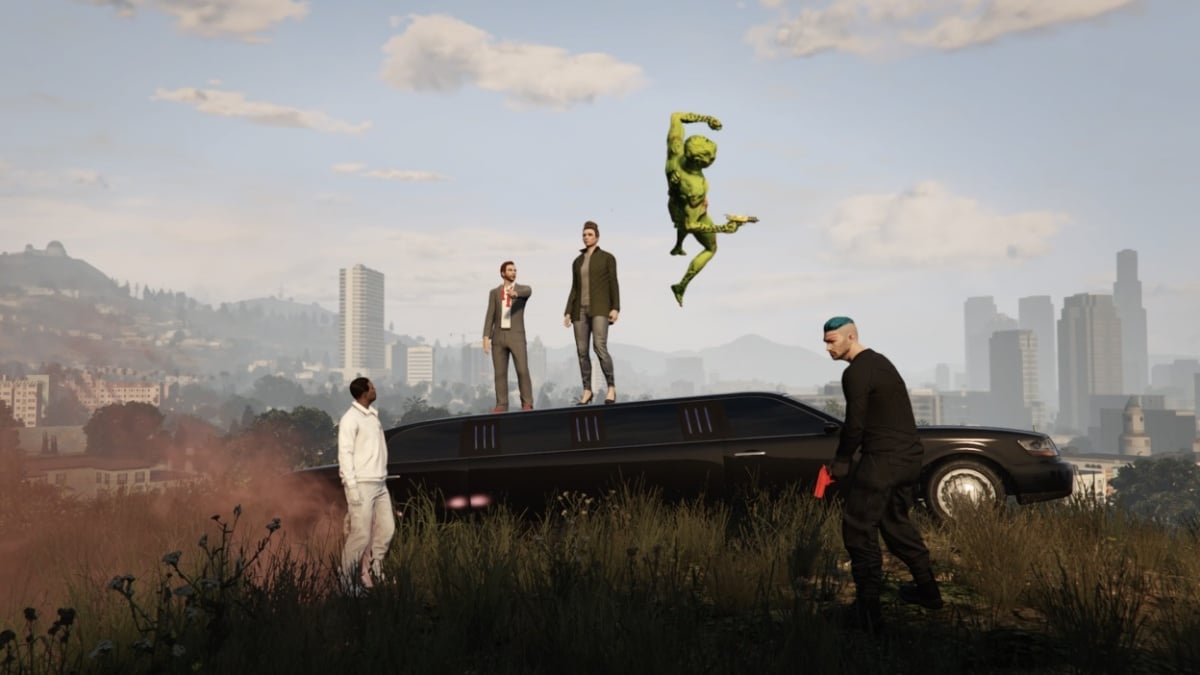Entertainment
‘Grand Theft Hamlet’ review: ‘Grand Theft Auto’ meets Shakespeare in this video game documentary

There could not be a more mismatched pair of subjects than Shakespearean tragedy and rocket launchers fired at police choppers by men in silly hats. However, Grand Theft Hamlet explores this unique combination of past and present while revealing new and unexpected narrative layers at every turn. The animated documentary follows two actors’ ill-advised attempts to stage a full-length production of Hamlet in a video game world; the result is riotously funny and surprisingly moving.
The winner of this year’s SXSW Grand Jury Award in the Documentary Feature category — disclosure: This critic was one of the jurists — Grand Theft Hamlet also happens to be a COVID lockdown piece, one that captures the absurdity of isolation in a way few recent films have. It’s as much a story about video games as it is about community and finding new avenues of emotional connection, and it runs the emotional gamut while exploring these ideas.
A unique synthesis of form, it creatively tackles the topic of artistic frustrations while reflecting on mortality in the silliest possible ways. It’s thoughtful and brash in equal measure, and by the end of its mere 89 minutes — brevity is the soul of wit, after all — the movie works despite all odds, proving to be a complete and utter blast.
What is Grand Theft Hamlet about?
The film begins as a run-of-the-mill “Let’s Play” — i.e., footage presented from within the game while other people play it — focusing on a pair of casual gamers passing the time by committing violent crimes and evading the police, as is encouraged in Grand Theft Auto. As much as watching other people play video games has become a streaming cottage industry, it may not seem like the most interesting way to make a feature film. However, Grand Theft Hamlet quickly dispels this notion.
The concept behind the movie is ludicrous at its core, harkening back to the days of Red vs. Blue, the popular (and still ongoing) sci-fi web series that had began in 2003 and is animated entirely in the world of first-person-shooter Halo. However, Grand Theft Hamlet’s appeal is hardly limited to the hardcore gaming crowd. Its initial footage serves to introduce non-gamers to the goofy hyper-violence of Grand Theft Auto, as a pair of lively, out-of-work English stage actors, Sam Crane and Mark Oosterveen — fellows of infinite jest — stumble upon an amphitheater within the game (the “Vinewood Bowl,” modeled off the Hollywood Bowl in Los Angeles). Before long, inspiration strikes, and they decide to see what it would take to stage an entire production of Hamlet within this shared online metaverse.
What seems, at first, like a disposable YouTube sketch becomes quickly engaging, as the movie begins chronicling its subjects’ attempts to hold auditions and rehearsal within Grand Theft Auto Online (the MMORPG component of Grand Theft Auto V; emphasis on “RPG”). All the footage featured in the movie is captured within the game itself. Shot from a multitude of angles that swing around freely, untethered from physical space, the film is co-directed by Crane and his romantic partner, the filmmaker Pinny Grylls, who not only functions as observer and digital archivist, but enters the game as a character alongside Crane and Oosterveen. Eventually, she becomes one of the movie’s main subjects herself.
After the leading duo puts out numerous calls on digital message boards, they finally find a handful of potential collaborators — whether other eager performers, novice gamers looking to keep busy during lockdown, or curious onlookers who don’t quite understand what they’re attempting, but go along with it anyway. The simple task of staging a performance and drawing viewers and participants proves hilariously difficult, given the nature of the game. As they gather fellow actors within this digital space, with each one performing soliloquies over headsets as their avatars repeat a series of limited gestures, in-world cops and other online players often disrupt Crane and Oosterveen’s peaceful gatherings. Grand Theft Auto is an inherently hedonistic world, and there’s nothing stopping some random third party from showing up, guns-a-blazing (or fists-a-swinging) just for the thrill of it. These frequent interruptions lead to resigned sighs from the accidental Rosencrantz and Guildenstern pairing each time they die and have to respawn in some inconvenient, far-flung location before making their way back to the digital stage.
It’s Theater Camp meets Punisher: War Zone, a bizarre, farcical blend of good-natured creativity and cartoonish hyper-violence that places a number of unique logistical roadblocks in the actors’ paths.
Grand Theft Hamlet is a truly unique lockdown film.
Shot mostly in early 2021, as London was undergoing its third major COVID lockdown, Grand Theft Hamlet traces the evolution of its central concept from a product of boredom to a sincere and sprawling passion project. Over several months, the resultant attempts and misfires to stage this production take increasingly frustrating forms, not only thanks to the in-world logistics — how do you craft a peaceful community experience in a space dedicated to bullets and bombs? — but also due to real-world logistics.
Anyone with even minimal high school stage experience will likely recognize the complications therein, and the ways in which Crane and Oosterveen — disembodied voices emanating from the mouths of digital avatars — politely navigate each problem. From turning down prospective performers who show up to audition at the Vinewood Bowl to trying to convince people of their vision to balancing people’s real-world schedules when deciding on times and places to practice in-game, Grand Theft Hamlet ends up a shockingly accurate depiction of the many hurdles that arise in the amateur theatre world, albeit with the added drawback of mischievous interlopers crashing rehearsals just to shank the actors or blow them to smithereens. That part isn’t quite so familiar to the performers, and it keeps them on their toes, while also making the whole exercise feel like cabin fever-induced madness.
The further Crane and Oosterveen get into their staging, the more complicated it becomes. Soon, it becomes a traveling production within the world of the game, as curious audience members are asked to follow the actors between a multitude of dangerous locations, like atop a floating blimp, a creative ambition that’s sure to result in self-sabotage, as the actors’ avatars die mid-performance courtesy of side-splitting accidents. However, the more time they spend trying to spice up their version of Hamlet, the more the real world begins to creep in through the corners of the frame.
Society wasn’t going to remain at a standstill forever, and their actors were bound to be pulled in different directions as soon as circumstances changed. However, a key element of the drama is also the relationship between the play’s two directors, and how their differing personal lives (Crane is a family man; Oosterveen is more of a loner) intersect with the movie’s premise. The pandemic and its ensuing lockdowns affected people in different ways, but what Grand Theft Hamlet manages to capture is how people emerged from the pandemic mindset at different times, and how this discrepancy may have strained relationships in the process.
The romantic relationship between Crane and Grylls is a key fixture of the movie too, and Grylls seemingly stages key conversations between them within the world of the game, even though they live in the same household. It’s hardly naturalistic, but it uses the same creative logic as modern reality television, where real tensions and interpersonal dynamics are heightened for an audience’s gaze. The key difference is that this bit of relationship drama also ends up at the mercy of the game’s mechanics, in piercingly funny ways that blur the lines between public and private moments.
However, these mechanics also provide a unique contrast to the subject matter at hand.
Grand Theft Hamlet is a surprisingly poignant reflection on death.
Between the movie’s pandemic premise and its subjects ruminating on one of Shakespeare’s heaviest texts, Grand Theft Hamlet echoes the idea of mortality in several quiet ways — the idea of what it means “to be, or not to be” — all while blaring explosions keep interrupting the actors’ attempts to rehearse.
There is perhaps no more surreal a space in which to reflect on dying than inside a video game where violence is so common and cartoonish that one becomes desensitized to death, since it’s a little more than a repetitive annoyance as bodies are flung in different directions. However, this casually brutal backdrop also forces the play’s macabre themes of vengeance and cosmic inevitability to the surface, via farcical depictions of deadly violence that — intentionally or otherwise — function as heightened re-enactments of the text.
If anything, the medium of Grand Theft Auto ends up the perfect spoonful of sugar for Shakespeare’s enduring, contemplative medicine. This constant unfurling of the play’s subtext turns the movie into an inadvertent act of arts criticism in the process, one where ostentatiously customized player avatars, with brightly colored hair and superhero outfits, function both as de facto philosophers and as deeply personal externalizations of the actors’ personas and neuroses.
One character in particular, a North African immigrant unfamiliar with the play, auditions with a Quran verse instead, while appearing in the form of a bright green alien. It’s as though he were both disguising himself and creating a cartoonish manifestation of the way he feels as a newcomer to English society, and it ends up being one of the film’s most touching reflections on the human experience.
The film maintains a razor-thin line between life and death, not only thanks to how easily the game’s digital avatars are turned into bloody pulp, but also because of the way these violent images are thrown headfirst into textual analysis and repetition each time the actors rehearse. The very act of performance — of channeling emotions and turning them into art — is one of the most vivid, human, and alive processes of which we’re capable. So, to be able to perform despite being robbed of traditional performance spaces is practically defiant, spitting in the face of a deadly plague in the most uproarious way. There’s nothing quite like Grand Theft Hamlet.
-

 Entertainment7 days ago
Entertainment7 days agoThis nova is on the verge of exploding. You could see it any day now.
-

 Business7 days ago
Business7 days agoIndia’s election overshadowed by the rise of online misinformation
-

 Business6 days ago
Business6 days agoThis camera trades pictures for AI poetry
-

 Business5 days ago
Business5 days agoTikTok Shop expands its secondhand luxury fashion offering to the UK
-

 Business6 days ago
Business6 days agoBoston Dynamics unveils a new robot, controversy over MKBHD, and layoffs at Tesla
-

 Business5 days ago
Business5 days agoMood.camera is an iOS app that feels like using a retro analog camera
-

 Business4 days ago
Business4 days agoUnitedHealth says Change hackers stole health data on ‘substantial proportion of people in America’
-

 Business3 days ago
Business3 days agoTesla’s new growth plan is centered around mysterious cheaper models




























